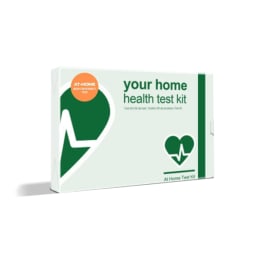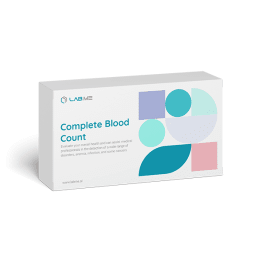
Registered Nurse (RN)
Registered Nurse (RN)
Amanda is a registered nurse with over a decade of experience in clinical nursing and a member of the Association of Healthcare Journalists.

December 3, 2022
Our editors have independently chosen the products listed on this page. If you purchase something mentioned in this article, we may
If you haven’t given your iron levels a second thought until now, you’re not alone. Iron deficiency is the most common nutritional deficiency in the world, with 30 percent of the worldwide population1 being iron-deficient. Factors like food availability contribute to this number being larger in developing countries than in first-world countries, but a staggering 10 million people in the U.S. are iron deficient1. So, even if you eat a diet rich in iron, it’s still a good idea to keep an eye on your levels with an at-home iron deficiency test or (preferably) a trip to the doctor, as this nutrient is actually among the most difficult to absorb—especially if you’re relying on plant-based food sources.
You may have heard the term anemia, and refer to it simultaneously as iron deficiency—but the two conditions have clinical differences. Iron deficiency (ID) is defined as the decrease in the total content of iron2 in the body. Iron deficiency anemia (IDA) occurs when iron deficiency is severe enough to reduce the production of red blood cells. And while, yes, they are clinically different, iron deficiency can be a precursor to iron-deficient anemia.
ID may be the result of either excessive blood loss or decreased absorption and storage of iron. This fine balance of iron input and output is easily disturbed by either excessive output such as bleeding or decreased intake through a diet low in iron-rich foods.
A simple blood test can determine the levels of iron and ferritin (iron stored in your body). However, asking your healthcare provider to order iron tests can be time-consuming and expensive, as you’ll often need to travel to a costly lab to have your blood drawn, and then wait for your doctor to relay your results. As a remedy to this often costly, lengthy process, at-home lab testing is becoming more and more commonplace. People can now order tests from the comfort of their homes, mail in the samples, and receive results within days—all for a flat rate.
Keep reading to find out the best at-home iron deficiency tests we’ve found, and to learn more about why iron is an important nutrient.
The best iron deficiency tests of 2022:
What is iron?
Iron is a mineral that is essential for our bodies to function. Most importantly, it is part of hemoglobin, a protein which carries oxygen throughout our body. It also is part of myoglobin, a protein that stores oxygen in muscles—which explains why fatigue is one of the leading symptoms of iron deficiency, caused by the lack of oxygen to your organs and muscles.
Iron is essential for healthy brain development and growth in children as well, along with the normal functioning of various cells and hormones.
A lack of iron affects the number of red blood cells carrying oxygen to essential organs like the brain and heart. Being deficient in iron can cause a myriad of symptoms, and can lead to iron-deficient anemia.
- Blood loss through trauma, menstrual cycles, and pregnancy
- Poor diet low in iron-rich foods
- Inability to absorb iron from foods in the intestines from diseases such as celiac, ulcerative colitis, Crohn’s, helicobacter pylori, and stomach surgery
Causes of iron overdose:
Food is our main source of iron, and a diet sufficient in iron will typically sustain normal levels in our bodies—as long as there are no underlying issues with absorption. Foods contain two types of iron, heme and non-heme. Heme iron comes from meat, fish, and poultry. Heme iron is much more easily absorbed compared to non-heme. Non-heme iron is found in plant-based foods such as nuts, fruits, and vegetables- but at much lower levels.
When diets in the U.S. became more processed, more Americans became iron deficient. The prevalence of iron-fortified foods began in 19403, as a way to combat the rise of anemia in the U.S.
What does low iron mean?
Low iron levels have a cascade of symptoms stemming from a basic lack of oxygen to your organs. Because iron is vital to hemoglobin, which transports oxygen to your organs, any lack of iron will slow down this process.
Common symptoms of low iron:
- Fatigue
- Weakness
- Shortness of breath
- Tachycardia (fast heart rate)
- Headache
- Dizziness/lightheadedness
- Pale skin
- Adult Males: 24 to 336 ng/mL
- Adult Females: 24 to 307 ng/mL
- Pregnant Females >40 ng/mL
- Children 6 months to 15 years: 7 to 140 ng/mL
Should you discover that you are, in fact, iron deficient, what happens next? First, discuss the results of your at-home or traditional lab tests with your healthcare provider. They may need to order additional tests to discover more about your iron health and the need for iron supplementation.
Iron supplementation comes in different forms, based on the root cause of your deficiency—which could be a myriad of things, including: low iron intake, trouble storing iron, issues transporting iron to your organs, or a dysfunction in absorption.
Depending on the determined cause, your healthcare provider may recommend one or more of the following actions:
- Increase your iron-rich food intake, especially heme iron
- Take an iron supplement
- Increasing vitamin C intake (to assist with absorption of iron)
- Intravenous (IV) iron supplements
- Blood transfusions
- Surgery to stop any internal bleeding
How to test for iron deficiency anemia at home?
While iron deficiency is extremely prevalent, iron-specific tests are not as common as other at-home tests on the market today. A true iron deficiency diagnosis will take at least an iron, ferritin, and total iron binding capacity (TIBC) test to see the full picture of how iron is being used by your body. However, at-home testing brands currently only offer ferritin tests, which is the amount of iron stored in your body.
Although these tests are a convenient and less expensive starting point, ferritin testing only gives you a glimpse of how iron is stored in your body. For instance, you could be eating a diet very high in iron, but your ferritin levels are still low. If you do not complete further testing, you would assume by the low ferritin number that you are not getting enough iron, whereas in reality your body is simply not absorbing it effectively.
With that being said, testing your ferritin can give you a basic understanding of how much iron your body currently has stored. The at-home tests are easy, quick, and a good starting point to discussing symptoms or concerns with your healthcare provider.
How does an at-home test measure iron?
At this time, at-home tests only offer ferritin testing. As mentioned, this is the amount of iron stored in the body. While this test alone does not diagnose a true iron deficiency, it does give a glimpse of your iron health. Formal iron testing incorporates the following lab tests:
- Total iron binding capacity (TIBC) test. The TIBC test checks whether there’s too much or too little iron in the bloodstream. It does this by measuring the total amount of iron that can be bound by proteins in the blood.
- Serum iron test. This test directly measures the level of iron in the liquid portion of the blood. It checks for abnormally high or low blood iron levels.
- Ferritin test. The ferritin blood test checks the level of iron stored in your body.
- Transferrin test. This directly measures the level of transferrin in the blood. Transferrin is the protein that transports iron around the body.
- Transferrin saturation percentage. A calculation that reflects the percentage of transferrin that is saturated with iron.
As you can see, by testing how iron is absorbed, stored, and transferred within your body, you will have a more complete illustration of your iron levels. Naturopathic doctor, Erica Steele, of Holistic Family Practice recommends including at least ferritin, TIBC, and transferrin saturation percentage tests to fully diagnose an iron deficiency.
How we picked:
The labs used by these at-home testing companies need to be regulated by the Clinical Laboratory Improvement Amendments (CLIA). We refer to this as CLIA-certified.
At-home testing is only truly convenient if it’s quicker than going to a lab. We looked for tests that will offer you speedier results.
Because these companies do not bill your health insurance, it’s important to note the charges associated with the tests. You may be able to use an HSA or FSA account to pay, but we always recommend checking with your account carrier first to confirm.
Serum iron at-home tests come in two options; finger prick (dropping blood into a vial) and blood spot (dropping blood onto a special paper testing paper.) We included options for both.
Our picks for the best at-home iron deficiency tests of 2022:
Allergy Test

Pros:
- Instant results (no mailing the sample back to a lab)
- Test packet is mailed to you within 1 to 3 days
Cons:
- Results only show normal or abnormal, rather than a quantitative result
- Based in the UK, which has different lab standards than the U.S.
Collection Method: Blood; blood spot
Coverage: Does not bill insuranceDoes accept HSA or FSA payments
Checks Levels Of: Ferritin
Result Time: 1 hour
This is a distinct type of ferritin test, as the results are almost instant. Much like an at-home COVID-19 or urine pregnancy test, the test outcome will be visible within minutes—so there is no need to mail in your sample and wait for results. While this sounds incredibly convenient and does save you a lot of time, the disadvantage is that your result is simply labeled as “normal” or “abnormal.” The test does not offer a quantitative number to show how low or high your levels are.
Typically, if your iron test result is just on the cusp of abnormal, you can make small dietary changes to increase your iron levels. However, if your levels are very low you may need to take an iron supplement. It’s important to speak with a doctor to get a better understanding of why your levels are low, and how to proceed from there. Equally important, you would not want to start taking a significant amount of iron supplements without consulting a doctor, as too much iron can cause other issues.
It’s important to note that this company is based in the U.K. so its standards for “normal” may differ from the U.S.
That said, this test could be another good jumping off point if you are experiencing symptoms or concerns and want to get a better idea of whether or not you’re deficient, before going to see your doctor.
Lab Me

Pros:
- Includes a detailed instructional video
- Uses CLIA and College of American Pathologists (CAP) certified labs
Collection Method: Blood; finger prick
Coverage: Does not bill insuranceDoes not accept HSA or FSA payments
Checks Levels Of: Ferritin
Result Time: 2 to 7 business days
Like the previous two, the Lab Me kit tests ferritin levels only. As mentioned, this only gives a small window into your iron levels. This test does include a detailed instructional video outlining directions on how to perform your finger prick blood sample that is clear and concise.
The brand is clear in its instructions to use the test before 9am, after fasting for six to eight hours. According to the website, results will be ready anywhere from 2 to 7 business days.
Cerascreen

Pros:
- Quantitative detailed report of ferritin levels
- Results come through a secure portal and app
- General recommendations based on results included
Cons:
- Only tests for ferritin
- The only option is to buy a 2-pack for $105
Collection Method: Blood; finger prick
Coverage: Does not bill insuranceDoes accept HSA and FSA payments
Checks Levels Of: Ferritin
Result Time: 7 days
This at-home ferritin test offers a detailed result report through a secure portal. The simple finger-prick sample method is quick and easy for almost any adult to conduct.
Cerascreen is very transparent in explaining that the test result values are not meant for pregnant or breastfeeding mothers. If pregnant or breastfeeding, your results will still reveal an accurate level, but the test may mark them as abnormal when they actually could be normal based on your iron needs during this time. You will need to do your own research on normal levels for pregnant and breastfeeding mothers, or discuss it further with your healthcare provider.
This company does not offer any type of follow up to discuss your results. While the company does provide general recommendations based on results, it’s important to recognize that these will not be specific to you and your individual circumstances—so if you do receive abnormal results, or are experiencing symptoms or concerns, it is best that you schedule an appointment with your doctor to discuss and potentially run additional tests.
Who should use an at-home iron deficiency test?
If you have symptoms of low iron, you might want to use an at-home test to check your ferritin levels. People who are taking an iron supplement will also want to monitor their iron levels regularly, to make sure they are not over-supplementing. Vegetarians and vegans need to pay close attention to their iron levels, in order to be sure they are consuming enough iron from non-heme sources. At-home tests are convenient and cost effective for each of these purposes.
The drawback of at-home iron testing is that, at this time, the only option is to test only your ferritin levels. The total iron-binding capacity (TIBC) is another element of iron testing that is not available for home-testing, along with serum iron. Getting a full picture of iron deficiency takes more than one test—so a visit to your doctor is always recommended.
Dr. Steele also points out that those who are minorities or from indigenous backgrounds are more prone to iron deficiencies, and, if it suits their budgets, at-home testing could offer these groups access to care.
FAQ:
Can you test your iron levels at home?
Yes, sort of. At-home lab tests have become just as accurate as traditional labs, allowing consumers to test their iron levels from the comfort of their homes. However, these at-home tests only include ferritin tests at this time, so further lab testing will most likely be required for an official iron deficiency diagnosis.
It is important to remember that symptoms also play a role in diagnosing iron deficiency. If your results reveal low ferritin levels, it’s imperative to discuss possible treatment with a healthcare provider. Overdosing on iron supplements can be extremely harmful to your health.
Can you self-diagnose iron deficiency?
The short answer is no. According to endocrinologist Dr. Omayra Quijano-Vega, a person can have symptoms that pertain to the possibility of an iron deficiency, which should be further investigated with the assistance of a healthcare professional to order the correct testing. You might even need a further specialty referral to include evaluation from a hematologist specialist.
If you are on TikTok, you may have heard of the coin or ring trick to diagnose an iron deficiency. The premise behind this trick is that if the coin or ring leaves a black mark on your face, you are iron deficient. Unfortunately, this viral trend is not scientifically supported and experts presume the blackened mark is caused by either 1. A metallic object chemically reacting with makeup or 2. A mechanical remnant from the object. As mentioned, the best way to diagnose an iron deficiency is through lab testing with your doctor.
The takeaway.
Iron deficiency is the most common nutritional deficiency in the world, and your body may have an even more difficult time absorbing iron if you rely on a plant-based diet. Luckily, at-home testing accessibility has skyrocketed over the last few years—and while most companies only offer ferritin testing at this time, these at-home tests are a great foundation for taking charge of your health. We do recommend following up with a healthcare professional to discuss your symptoms and the need for further testing.

